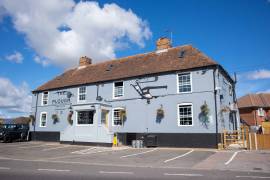Foundations laid for Punch's future plans

It's been a bit like one of those agonising relay races where it seems to take an age for the baton to be passed between runners.
It was early summer 2009 when Punch chief executive Giles Thorley first indicated his desire to step down. A full 14 or so months later his successor, Ian Dyson, former Marks & Spencer finance director, finally has his feet under the table at Punch headquarters in Burton this week.
Speculation has already begun about what difference Dyson will make to strategy at Punch. Will he be keener than his predecessor to consider a sale of the managed business to focus on leases?
What changes will he make to the leased operation to ensure it returns to growth after two very tough years? How will he gel with his two key lieutenants, tenanted boss Roger Whiteside and managed head Mike Tye.
The story of Punch in the past two or so years has two distinct themes. The first has been about selling pubs to raise cash so that the company creates headroom and therefore breathing space in its key securitised debt structures. This part has been achieved thanks to last year's pub jumble sale.
At the same time, attention has turned to improving operational performance within both its tenanted and managed division. The heady days of Punch expansion was not dissimilar to the basic tenets of the computer game Pacman, with the company hungrily gobbling down freehold estates wherever it could find them.
Punch bobbed along happily on the crest of the rising property values wave, successfully completing a series of sell-ons at a profit. (Thank goodness, from the Punch point of view, that Admiral Taverns stole in to buy one last batch of smoke-ban vulnerable pubs in April 2007).
At the back of someone's mind was the notion that Punch was carving out high-quality pubs within the tenanted and managed estates. The past couple of years has shown that the company had been negligent on two fronts: being sufficiently rigorous in sifting for quality and creating a holistic strategy around operational focus.
Leased turnaround
On the tenanted side, senior sources at Punch readily admit there was virtually nothing by way of a plan for the tenanted division that was about engineering organic growth (as opposed to the growth that comes from the contractual levers of wholesale price and rent increases) before the arrival of Whiteside.
The former Marks & Spencer executive has moved in all the right directions since his arrival. He's reforming corporate culture around the landlord/tenant sine qua nons of "trust and transparency".
There's a new and refreshing push centred around attracting, keeping and rewarding the best tenant talent. Tenants are getting Punch investment in under-invested sites and volume incentives to encourage out-performance.
And there are initiatives to grow tenant bottom line by leveraging its managed division scale. Lease agreements have moved broadly in the right direction. The on-going challenge is for Punch business development managers and more senior staff to think and act with an ever-greater entrepreneurial spirit.
The aforementioned lease agreements, for example, can be framed with a virtually infinite degree of imagination to tempt and reward good licensees (and tie the landlord's hands to avoid profit creep at the expense of the licensee).
For now, Punch leased like-for-likes are stubbornly stuck at — 11% nearly two years after Whiteside's arrival.
But the headline figures don't do full justice to Whiteside. He's struggling with the lag effect of re-based rents that follow on from declining market-wide beer volumes.
And last year's sell-off saw a fair number of the division's best licensees buying their freehold, neutralising to a degree the boost to estate performance that should have come from selling bottom-end pubs.
Turning around the performance of a 6,000-pub strong leased division the sensible way, the organic way, is akin to turning around a super-tanker by remote control. Patience, a lot of patience, and a wholly different culture is required. But some time in the coming year or so the performance will need to stabilise.
Managed change of approach
Meanwhile, over in the managed division Mike Tye has now completed slightly more than two years of service.
The past three months have shown that the division has begun to return to growth — helped by the golden sauce of pub trading, summer sunshine — after a radical and deep-reaching change of approach.
Like Whiteside, Tye had to formulate a strategy where a void existed. His programme has had to address each and every one of the key components of a managed operation: people, training, retail content, service and investment. It was sign of confidence that progress is being made that City analysts were treated to a gruelling 10-hour tour of managed sites a fortnight ago — managed bosses were keen to show the City scribblers that plans had moved well beyond the woolly promises and high hopes that have accompanied a number of false dawns at the division.
A total of 200 sites — around 25% of the estate — have seen an average £150,000 investment so far. A total of 52 Chef & Brewer sites — the brand has suffered years of benign neglect — have had investment to transform them to a more modern and more mid-market formulation. So far, all but two sites have hit the 25% EBITDA Return on Investment (ROI) mark. A further sign of management confidence is a decision to uptick digital and web-based marketing spend by 30%.
Tye is also managing to do more for less — he's reduced development costs per square foot from £90 to £33 and pub makeover down-times have been squeezed from 28 days to 10 days.
Underpinning the change programme has been a dizzying round of hiring and firing to upgrade staff quality — 80% of senior management, 60% of middle management and 50% of unit management have been replaced.
New brand templates have been arriving at the rate of footballer kiss-and-tell stories. And the process of origination and proof of concept can't be rushed. Rebranding in 2011 will focus on around 200 more sites in the Fayre and Square, Barras and Flaming Grill formats.
But there are plans to expand the carvery concept Roast Inn to 60 sites and the up-market gastro format Pub & Kitchen to 30 outlets that will inevitably need the right amount of slow-cooking.
It's looking like there are 50 or so managed sites that are not suited to rebranding plans and will need to go to market. But, interestingly, there's talk of converting just as many pubs from its leased division into managed outlets — this really is a sign of recovering belief in the division's retail skills.
As with the leased division, it has required and will require a lot of patience for Tye's efforts to really bear fruit.
In absolute terms, he's still probably no more than 25% to 30% through his estate recovery plan — although the back-end work involving people and processes is much further on.
In a sense, Dyson's arrival as chief executive is well timed. There's a chance to build on the work undertaken by Whiteside and Tye to realise the potential of what amounts to more than 10% of the entire UK's pub stock — the foundations are now in place.
















